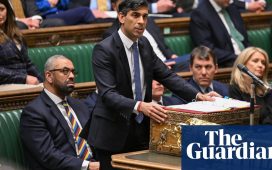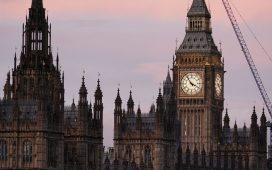Here are two numbers to bear in mind this election season: 83% and 23%. The first is the combined haul of the Conservatives and Labour in the 2017 general election, the highest since 1970. The second is their combined share in this year’s European parliament elections, the lowest in a nationwide poll since the mass franchise was introduced. In two years, the big two parties went from a once-in-a-generation high to an all-time low. As another election approaches, they are both working to claw these losses back. Downing Street awaits for the party best able to recover its lost support. Welcome to the “big squeeze” election.
Brexit is the common denominator behind both the surprise resurgence of two-party politics in 2017, and its sudden collapse this year. And Brexit will be the driving force again this winter. The Conservatives under Theresa May rose by squeezing the Ukip vote; now, under Boris Johnson, they are looking to squash support for Ukip’s successor, Nigel Farage’s Brexit party. Labour’s 2017 surge was driven in part by Remain voters who saw the party as best-placed to stop a Tory hard Brexit. Team Corbyn badly needs these Remainers to return to the fold.
One novelty in this election is the appearance of high-profile independents and switchers, most of whom are strongly associated with the Remain cause. Former Labour and Tory MPs standing now as Liberal Democrats, such as Luciana Berger or Sam Gyimah, may provide the party with attractive local champions to consolidate Remain support in seats where otherwise it would look out of the running. And pro-Remain independents such as Dominic Grieve may bring otherwise safe Conservative seats into play if they can consolidate Remain support from other parties while also bringing in Tory Remainers unwilling to back opposition parties. The weakening of traditional party loyalties, and the strengthening of Brexit loyalties, may facilitate this process, making it easier for prominent Remain politicians to gather support even if they stand without a traditional party banner.
These rebels and switchers may give Remainers a new advantage in seats where they stand, but it is the Conservatives who have the early advantage in the national squeeze stakes. Their poll numbers are up more than 10 points since the summer, with most of this increase coming from the Brexit party, whose support has halved over that period. Johnson’s embrace of a hard Brexit – and his success rallying Eurosceptic MPs and journalists behind his renegotiated deal – has given him a powerful squeeze argument to put to Brexit party voters, and this has driven his current polling lead. Yet his deal is new and poorly understood, and will now face a barrage of Brexit party criticism as Farage seeks to convince wavering Brexit party voters that Johnson’s deal is not a “real Brexit”.
Labour starts from a tougher position. Its ambiguous and evolving Brexit policy is not a great tool for persuading Remain voters, and Jeremy Corbyn is much less liked and trusted among partisan Remainers than Johnson is among Brexiters. Labour has made much less headway this autumn in winning back lost support.
It does, however, have some cards left to play. Its 2017 surge leaves it as the strongest competitor in most Tory-held seats, making credible its claim to be the only viable alternative to Johnson’s Brexit in most seats. The Conservatives’ early campaign advantage may also be a help if it persuades wavering Remain voters that, whatever their reservations about Corbyn, a Labour vote is their last chance to stop Brexit.
The smaller parties can play the squeeze game, too. The SNP is in second place in all Conservative-held Scottish seats, and has been campaigning hard for the votes of Scottish Labour and Lib Dem voters as the best-placed “stop Brexit” party in these seats. The Lib Dems also start second to the Conservatives in many Remain-leaning seats elsewhere, often with a substantial Labour vote available to squeeze. The failure of Labour to consolidate Remain support nationally is less of a problem if several Remain parties mount local squeeze operations across different contexts, threatening Conservative incumbents on several fronts.
Tactical alliances can further this goal, and the smaller Remain parties have pursued them with much more gusto in this election than the last, though Labour remains aloof. The Lib Dems, Plaid Cymru and the Greens have announced “Unite to Remain”, a plan to coordinate candidates across 60 seats. Such formal pacts may be augmented by informal arrangements on the ground, with weaker parties standing “paper” candidates and limiting their campaigning. It is not clear how voters will react to this unprecedented coordination between parties. While pooling resources behind a unity candidate should yield gains, it is not clear how voters denied their first preference choice will react. Many Plaid Cymru and Green voters have a pretty dim view of the Lib Dems, and may opt to stay home or back Labour instead.
All these squeeze strategies rely on voters being willing to accept second best to prevent the worst. But will they? The traditional parties are weak and distrusted, which limits their persuasive power. And with opinion on Brexit more polarised than ever, more voters than ever may be unwilling to compromise on their ideals. The massive surges in support for new parties this year may have given many voters a taste for radical change that proves hard to rein in. A long campaign will give the Brexit insurgents plenty of opportunities to push back against the big parties’ squeeze messages. Will Leave voters see this vote as a chance to “get Brexit done”, or to register their anger at Brexit being “betrayed”? Will Remain voters come to see Labour as their last best hope, or as a party that has already failed them? The squeeze is on.
Rob Ford is a professor of politics at the University of Manchester














